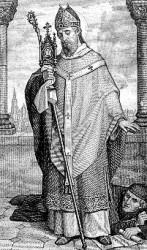 St. Norbert
Name: St. Norbert
Date: 6 June
Born near Cologne in 1080, Saint Norbert, of noble rank and rare talents, passed a frivolousyouth, abandoning himself to the pleasures and vanities of the world. Though he was a canon ofthe church, he refused to receive ecclesiastical Orders so as to continue to live in his caprices. Hewent to the court of the Archbishop of Cologne, then to that of the Emperor Henry IV, thefamous adversary of Pope Saint Gregory VII, known also as Hildebrand. His conduct thenbecame a scandal to his sacred calling, since at the court of the Emperor, like many clerics ofthose times, he was leading a life of dissipation and luxury. One day, when he was thirty-three years of age, he was thrown from his horse in the midst of aterrible storm, and on recovering his senses a half hour later, he resolved upon a new life. After asevere and searching preparation, he went to the Archbishop of Cologne and humbly asked toreceive Holy Orders. He was ordained a priest and began to preach against all the abuses andvices of his time. He encountered enemies and was silenced at first by a local council; however,he obtained the Pope’s sanction and preached penance to listening crowds in France and theNetherlands. His example spoke still more eloquently than his words; he walked barefoot in thesnows and wore a tunic which was a hair shirt, fasting all year long. He was compared to Johnthe Baptist by his austerity and by the fervor of his preaching. A chaplain of the bishop of Cambrai, impressed by the extraordinary changes in the formernobleman of the Emperor’s court, asked to join him; this good priest, by the name of Hugh, laterwould succeed him in the government of the new religious Order which he was soon to found. Inevery place where Saint Norbert preached, those in attendance saw sinners converted, enemiesreconciled and usurers return extorted wealth. The bishop of Cambrai desired that he found a monastery and a new Order in his diocese, and theholy monk recognized at once, in a wild vale later called Premontre, the place he should choose. There he was favored, during a night of prayer, with a vision of many white-robed monks inprocession with crucifixes and candles; the Blessed Virgin also appeared to him and showed himthe habit he should give his religious. It was in 1120 that he gave to some trained disciples therule of Saint Augustine, with the white habit he had been shown, denoting the angelic purityproper to the priesthood. The Canons Regular, or Premonstratensians, as they were called, wereto unite the active work of the country clergy with the obligations of the monastic life. Thefoundations multiplied, and the fervor of these religious priests renewed the spirit of the priesthood, quickened the faith of the people, and overcame heresy. In the time of Saint Norbert a pernicious heretic named Tankelin appeared at Antwerp, denyingthe reality of the priesthood, and above all blaspheming the Holy Eucharist. The Saint was sentfor, to quench the error and its source, since three thousand persons had followed this man, whowas allowing every vice to pass for legitimate. By Saint Norbert’s burning words he exposed theimpostor, corrected the erring, and rekindled faith in the Blessed Sacrament. Many of theapostates had proved their contempt for the Blessed Sacrament by burying it in walls and dampplaces; Norbert bade the converted ones search for the Sacred Hosts. They found them entire anduninjured, and the Saint bore them back in triumph to the tabernacle. Hence he is generallyportrayed with the monstrance in his hand. In 1126, Norbert was appointed Bishop of Magdeburg; and there, at the risk of his life, hezealously carried on his work of reform until he died, worn out with toil, at the age of fifty-three. |